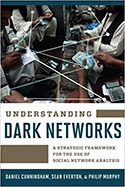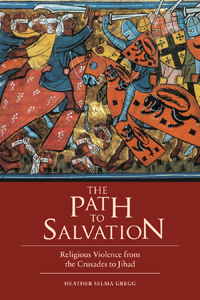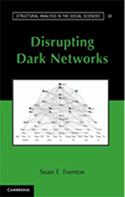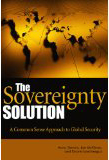DA Department Publications - Department of Defense Analysis
DA Department Faculty Publications
Books & Chapters
Understanding dark networks : a strategic framework for the use of social network analysis
by Daniel Cunningham, Sean Everton and Philip Murphy
 Dark networks are the illegal and covert networks (e.g, insurgents, jihadi groups, or drug cartels) that security and intelligence analysts must track and identify to be able to disrupt and dismantle them. This text explains how this can be done by using the Social Network Analysis (Sna) method. Written in an accessible manner, it provides an introduction to Sna, presenting tools and concepts, and showing how Sna can inform the crafting of a wide array of strategies for the tracking and disrupting of dark networks
Dark networks are the illegal and covert networks (e.g, insurgents, jihadi groups, or drug cartels) that security and intelligence analysts must track and identify to be able to disrupt and dismantle them. This text explains how this can be done by using the Social Network Analysis (Sna) method. Written in an accessible manner, it provides an introduction to Sna, presenting tools and concepts, and showing how Sna can inform the crafting of a wide array of strategies for the tracking and disrupting of dark networks
Rational Empires: Institutional Incentives and Imperial Expansion
by Leo J. Blanken
 Imperialism remains a perennial issue in international relations today, and nowhere is this more evident than in the intensifying competition for global resources. Leo J. Blanken explains imperialism through an analysis of the institutions of both the expanding state and its targets of conquest.
Imperialism remains a perennial issue in international relations today, and nowhere is this more evident than in the intensifying competition for global resources. Leo J. Blanken explains imperialism through an analysis of the institutions of both the expanding state and its targets of conquest.
The Path to Salvation: Religious Violence from the Crusades to Jihad
by Heather Gregg
 In the wake of 9/11, many have tried to make sense of the rise of militant Islam. The general perception is that Islam is more violence prone than other religions. Here, however, Heather S. Gregg draws comparisons across religious traditions to investigate common causes of religious violence. The author sets side by side examples of current and historic Islamic violence with similar acts by Christian, Jewish, Buddhist, and Hindu adherents.
In the wake of 9/11, many have tried to make sense of the rise of militant Islam. The general perception is that Islam is more violence prone than other religions. Here, however, Heather S. Gregg draws comparisons across religious traditions to investigate common causes of religious violence. The author sets side by side examples of current and historic Islamic violence with similar acts by Christian, Jewish, Buddhist, and Hindu adherents.
Based on her findings, Gregg challenges the assumption that religious violence stems from a faith’s scriptures. Instead, Gregg argues that religious violence is the result of interpretations of a religion’s beliefs and scriptures. Interpretations calling for violence in the name of a faith are the product of individuals, but it is important to understand the conditions under which these violent interpretations of a religion occur.
Disrupting Dark Networks
by Sean F. Everton
 This is the first book in which counterinsurgency theory and social network analysis are coupled. Disrupting Dark Networks focuses on how social network analysis can be used to craft strategies to track, destabilize, and disrupt covert and illegal networks.
This is the first book in which counterinsurgency theory and social network analysis are coupled. Disrupting Dark Networks focuses on how social network analysis can be used to craft strategies to track, destabilize, and disrupt covert and illegal networks.
The Sovereignty Solution
by Anna Simons
 In The Sovereignty Solution: A Commonsense Approach to Global Security (Naval Institute Press, 2011) Professor Anna Simons and Department of Defense Analysis graduates LTC Joe McGraw, USA, and LTC Duane Lauchengco, USA, propose a foreign policy emphasizing every nation's responsibility--including America's--to control security and the social fabric within its own borders.
In The Sovereignty Solution: A Commonsense Approach to Global Security (Naval Institute Press, 2011) Professor Anna Simons and Department of Defense Analysis graduates LTC Joe McGraw, USA, and LTC Duane Lauchengco, USA, propose a foreign policy emphasizing every nation's responsibility--including America's--to control security and the social fabric within its own borders.
Simons and her Special Forces coauthors argue that the U.S. has never articulated the clear position on national defense, "respect our sovereignty and we will respect yours." The Sovereignty Solution is a radical, yet sensible, approach to global security and world order that doesn't require the U.S. to engage in global policing or nation building.
The book's goal is to provoke heightened awareness of the gaps and disconnects between what the U.S. says and what it does, how it wants to be perceived and how it is perceived. Without leaning left or right, the authors hope to initiate a serious debate and to force Washington to rethink what it sends servicemen and women abroad to do.
Ten officers in the DA department participated in the study and were instrumental in pulling the overall argument together.
Technical Reports
Cyber Analogies
by Emily O. Goldman and John Arquilla
This anthology of cyber analogies will resonate with readers whose duties call for them to set strategies to protect the virtual domain and determine the policies that govern it. Our belief is that learning is most effective when concepts under consideration can be aligned with already-existing understanding or knowledge. Cyber issues are inherently tough to explain in layman's terms. The future is always open and undetermined, and the numbers of actors and the complexity of their relations are too great to give definitive guidance about future developments. In this respect, historical analogies, carefully developed and properly applied, help indicate a direction for action by reducing complexity and making the future at least cognately manageable.
Journal Articles
See all DKL-curated journal articles here.
Professor John Arquilla:
Communications of the ACM articles here.
Foreign Policy articles here.
New York Times articles here.
San Francisco Chronicle articles here.
